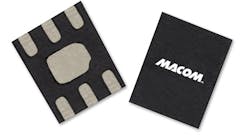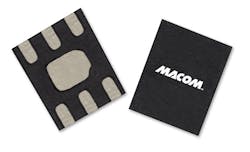This file type includes high resolution graphics and schematics when applicable.
From radios to test equipment, microwave mixers are still at the heart of many high-frequency systems. A trio of new discrete mixers from MACOM Technology Solutions packs outstanding frequency-conversion performance across a total frequency range of 5 to 33 GHz into miniature plastic surface-mount housings. The trio consists of the high-linearity model MAMX-011021, the image-reject mixer model MAMX-011022, and the low-noise active mixer model MAMX-011023 (see photo).
The high-linearity model MAMX-011021 mixer provides the widest frequency coverage of the three, with an RF range of at 5 to 33 GHz and an LO frequency range of 3 to 39 GHz; it is well suited for such applications as high-bit-rate digital transmitters and receivers. It offers an intermediate-frequency (IF) range of DC to 5 GHz by way of approximately 9-dB conversion loss. The mixer is based on a single-ended cold (passive) field-effect-transistor (FET) configuration with diplexer. It achieves an input third-order intercept point (IIP3) of +22 dBm to maintain low distortion over its wide frequency range and in myriad signal-power conditions.
While the model MAMX-011021 mixer does not require bias voltage, it can be used with positive bias voltage of less than +1 VDC to reduce the LO drive requirements. The mixer can operate in frequency upconversion and downconversion applications, and a pair of the mixers can be set in a quadrature configuration for image-reject mixing.
The model MAMX-011022 passive image reject mixer is targeted at medium-data-rate, long-haul, low noise systems, and can be used for both frequency upconversion and downconversion (although it is primarily designed for downconversion purposes). This tiny mixer can operate without a bias source; it spans an RF range of 5 to 28 GHz, an LO range of 2 to 28 GHz, and an IF range of DC to 5 GHz. It provides image rejection of 18 dB with typical conversion loss and noise figure of 12 dB measured at test frequencies of 6, 18, and 26 GHz.
The mixer integrates a 90-deg. balun into a balanced subminiature mixing core to achieve its wideband frequency coverage. Model MAMX-011022 handles RF inputs to +15 dBm and exhibits typical return loss of 8 dB at all three (RF, LO, IF) mixer ports. The mixer’s input 1-dB compression point is typically +15 dBm at 18 GHz. By supplying optional DC bias of +3 VDC at 2 mA, the RF linearity can be optimized.
Finally, model MAMX-011023 is a low-noise active mixer that maintains typical noise figure and conversion loss of only 7 dB for input signals through 23 GHz. It features an RF range of 4 to 23 GHz, an LO range of 4 to 23 GHz, and an IF range of DC to 8 GHz. Because this is an active mixer, it requires bias of +3 VDC and 15 mA. The mixer integrates a FET gain element with LO and RF driving the same pin, employing transconductance mixing to achieve the low noise figure. Model MAMX-011023 can be used for lower-sideband (LSB) or upper-sideband (USB) mixing, and can operate with relatively low LO levels (less than 0 dBm).
All three of these surface-mount mixers are supplied in industry-standard plastic TDFN packages measuring a mere 1.5 × 1.2 mm. All three mixers are designed for operating temperatures from -40 to +85°C.
MACOM Technology Solutions, Inc., 100 Chelmsford St., Lowell, MA 01851; (800) 366-2266, (978) 656-2500
This file type includes high resolution graphics and schematics when applicable.


